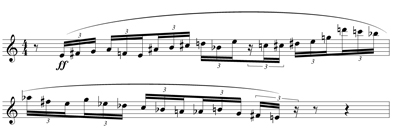Once in a while flutists encounter passages or small groups of notes that are difficult to learn. Sometimes a passage may be easy to play but difficult to remember from one practice session to the next. For younger players, a passage may be difficult because they have yet to develop a strong grasp of the theoretical foundation materials used in composition such as major and minor scales, thirds and sixths, arpeggios, and several seventh chords. For advanced flutists difficulties may arise with less familiar composing techniques such as serialism or scales such as octatonic, whole-tone, major or minor pentatonic, or thirds that are chromatic or whole-tone. On first sight the notes seem random, but of course they are not.
Less experienced flutists continue to stumble over these passages from one practice session or rehearsal to the next. Advanced flutists worry whether they will conquer the passage in time for the next rehearsal or concert. The goal for all flutists is to learn the passage so thoroughly they can play it with comfort and assurance. The following techniques will help master difficult passages and improve overall playing skills.
1. Fill in a Note with a Basic Skill.
Often a passage is difficult because the notes do not appear in the expected order. Step-wise motion is always easier to read than passages with wide skips. Passages with many accidentals and changes in time signature also can present problems. In order to read and learn the notes correctly, the flutist should slow the reading process. The basic technique of simply playing slower is not enough, however. As flutists slow the reading process, they should try to improve tone production, articulation, and vibrato consistency at the same time. This is what happens when a flutist fills in the subdivisions of each note using one of the seven basic skills.
The basic skills a flutist can employ when playing the flute are slurring, T, K, Hah, TK or TKT, counted vibrato, and flutter-tonguing. In 44 time the flutist fills in the mathematical equivalent in sixteenths for each note. For a whole note, the flutist plays 16 sixteenth notes; for a half-note 8 sixteenth notes; for a quarter 4 sixteenths notes; for an eighth note 2 sixteenth notes; and for a dotted quarter note 6 sixteenth notes. When filling in, the flutist plays the passage with each of the following skills: T, K, TK, Hah, and counted vibrato. After finishing this cycle (T, K, TK, Hah, vibrato), repeat the cycle of skills increasing the metronome speed. The goal for the T, K and TK is 144; while the goal for the Hahs and vibrato cycles is 80.
The K attack should be as far forward in the mouth as possible as if saying the word key. There should be no movement in the abdomen when using the Hah or breath attack. The Hah attack is produced in the vocal folds at the top of the larynx or voice box. The K and Hah attacks help the flutist learn to make the aperture (opening in the lips of the embouchure) smaller as these attacks will not be clean if the aperture is too large.
Repeat playing the passage at performance tempo, slurring and then flutter-tonguing. Flutter-tonguing is often overlooked as a practice technique for non-flutter-tongued passages, but, it should not be. It is one of the best ways to learn to control and move the air when playing. If the air stream is not moving, the flutter will not occur. Solving this air concept makes many a difficult passage sound easier.
2. By Omission.
Since the passage is written in triplets, first use the by omission practice technique based on a unit of three notes. Choose which notes you will play and which you will omit. This helps develop a scanning technique that is useful in fast passages. For example, begin by playing only the first note of each triplet, followed by two 1/16th rests. Then play the second note of the triplet with rests on 1 and 3, and finish with the third note. Practice this until you can do each of the three ways at an allegro tempo.
Repeat playing only notes 1 and 2 of each triplet followed by a rest, then a rest and notes 2 and 3 and finally 3 and 1 with a rest on 2. Repeat this technique based on six notes since this passage will eventually be played six notes to a beat in 44 time.
3. Learn the Intervals
Play the passage and place 6 vibrato cycles per note. Repeat using 5, 4, 3, and 2 vibrato cycles per note. Breathe when necessary. Practice this technique on each tick of the metronome from 80 down to 60. This technique allows the flutist to slow down the notes and accurately play what is written. Practice with counted vibrato also helps flutists play with a beautiful sound. Focus on the sound and make each note the highest quality with a good core. When the passage is played at performance tempo, a residue of this beautiful sound will remain.
4. Linger and Go.
In this exercise, the flutist chooses one note to linger on. Play each note of the passage with 2 to 6 vibrato cycles. On the linger note double the number of vibrato cycles. For example, first double the cycles on note number 1, then note number 2, and finally on the third note. Repeat this idea using the concept of six notes rather than three. When lingering on a note, again make it sound as beautiful as possible.
5. Articulations and Rhythms.
It is always useful to practice with alternate articulation and rhythm patterns. In this sample passage, there are five articulation choices for the triplets: all tongued; all slurred; slur 2, tongue 1; tongue 1, slur 2; and slur 3 to 1, tonguing 2. There are many rhythmic patterns possible, but two good options are to play the notes in groups of two as a dotted eighth followed by a sixteenth and conversely a sixteenth followed by a dotted eighth. Remember to also explore the various rhythms for groups of six notes.
6. Chunking.
This is a technique in which the flutist plays approximately one inch of musical notation followed by a rest of equal length. Begin by chunking three notes followed by a rest. Each chunk should be in performance tempo (if quarter = 120-124, then the triplet eighth is 240-248.
7. Add-A-Note or Add-A-Chunk Forwards and Backwards.
Begin by playing the first two notes of the passage slurred as fast as you can five times. If all five are perfect, add the next note and play the passage slurred as fast as you can five times. Continue adding a note until you can play the entire passage. Repeat this technique starting at the end of the passage working your way back to the beginning. Once I could play the John Adams passage backwards, I could always play it forward.
Repeat by playing the passages by chunks. Play the first triplet (chunk) five times slurred. Then add the next triplet chunk and play the two chunks five times in performance tempo. Repeat this exercise until you reach the end of the passage. Start at the end of the passage and add-a-chunk until you reach the beginning of the passage.
8. In Context.
Since I did not know the John Adams Chamber Symphony before I began working on it, I listened to the recording many times. Once I could play each individual passage well, I began playing with the recorded CD. This helped develop flow in my playing.
Most musicians who have performed this work have said it was one of the most challenging pieces to learn but not to play. Some passages could have been written in eighth notes with staccato markings above each note, but Adams choose to write some notes as eighths and others as sixteenth notes followed by a sixteenth rest to ensure the player has separation between each note. To play these passages with accuracy most players indicate the beats in each measure with a small slash or telephone pole. I also found that several of the passages were more easily understood if I changed the enharmonic notation. Unfortunately this was not a question I asked in the early stages of my practice. If I had thought of this sooner, I would have rewritten my part. This is an excellent work, but challenging to learn and remember.
Final Thought
Analysis is always a good technique to employ when difficulties arise. Get a full score to the composition and explore how your part fits into the whole work. Remember there is always one practice technique that works best for each difficult passage. Collect practice techniques by jotting ideas in a notebook. When you encounter the next hard to learn passage, use your assortment of practice tools. With time, you will discover which technique works best for you and with each passage.
* * *
One of the most challenging pieces to learn (but not play) is the John Adams Chamber Symphony. The 22-minute Chamber Symphony for 15 instruments was written in 1992 for the San Francisco Chamber Players and merges the essence of the Schoenberg Chamber Symphony with cartoon music of the 1950s. The flutist is required to alternate between piccolo and C flute throughout the three-movement work.
The following passage is written for the piccolo, but should be practiced on the flute first. The time signature is 4/4. Performance tempo is quarter = 120-124. Try the practice techniques in this article on the excerpt below, and then try them with trouble spots you encounter in other works.

Chamber Symphony: © 1993 by Hendon Music, Inc., a Boosey & Hawkes Company






